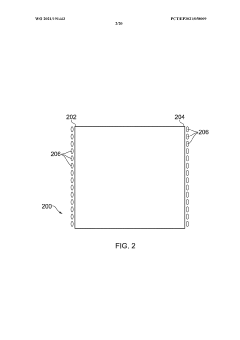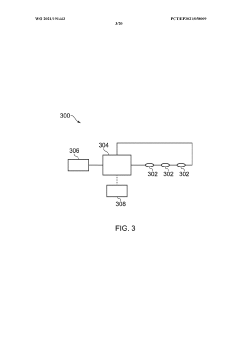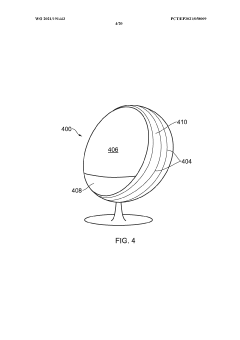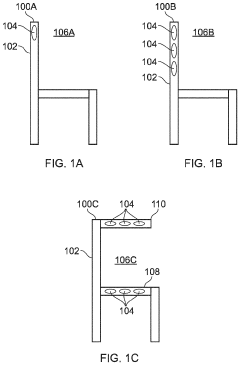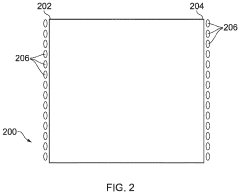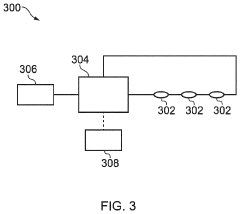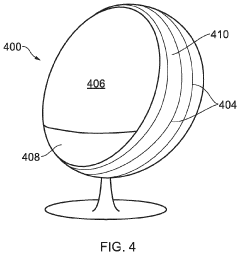how does the schumann resonance affect humans
JUN 24, 20259 MIN READ
Generate Your Research Report Instantly with AI Agent
Patsnap Eureka helps you evaluate technical feasibility & market potential.
Schumann Resonance Background and Objectives
The Schumann resonance, discovered by physicist Winfried Otto Schumann in 1952, is a set of spectrum peaks in the extremely low frequency (ELF) portion of the Earth's electromagnetic field spectrum. These resonances occur between the Earth's surface and the ionosphere, creating a global electromagnetic resonance phenomenon. The fundamental frequency of the Schumann resonance is approximately 7.83 Hz, with harmonics at higher frequencies.
The study of Schumann resonance and its potential effects on human physiology has gained increasing attention in recent years. This research aims to explore the intricate relationship between these natural electromagnetic frequencies and human biological processes. The primary objective is to determine whether and how the Schumann resonance influences human health, cognitive function, and overall well-being.
Throughout the evolution of life on Earth, organisms have been continuously exposed to these natural electromagnetic frequencies. This long-term exposure has led some researchers to hypothesize that the Schumann resonance may play a crucial role in regulating various biological rhythms and processes in living organisms, including humans.
The technological advancements in the past century have introduced a multitude of artificial electromagnetic fields, potentially disrupting the natural electromagnetic environment to which humans have adapted over millennia. This shift has sparked interest in understanding the importance of the Schumann resonance for human health and the potential consequences of its alteration or absence.
Recent studies have begun to investigate the correlation between Schumann resonance fluctuations and various physiological and psychological parameters in humans. These include brain activity, sleep patterns, cardiovascular function, and even mood and cognitive performance. The goal is to elucidate whether exposure to or synchronization with the Schumann resonance frequency can have beneficial effects on human health and well-being.
As we delve deeper into this field of research, we aim to uncover the mechanisms through which the Schumann resonance may interact with human biology. This includes exploring potential resonance effects between the Schumann frequency and various physiological rhythms, such as brain waves, heart rate variability, and circadian cycles.
Understanding the relationship between the Schumann resonance and human health could have far-reaching implications for various fields, including medicine, psychology, and environmental science. It may lead to the development of novel therapeutic approaches, inform the design of living and working environments, and contribute to our understanding of the intricate connections between human health and the Earth's natural electromagnetic environment.
The study of Schumann resonance and its potential effects on human physiology has gained increasing attention in recent years. This research aims to explore the intricate relationship between these natural electromagnetic frequencies and human biological processes. The primary objective is to determine whether and how the Schumann resonance influences human health, cognitive function, and overall well-being.
Throughout the evolution of life on Earth, organisms have been continuously exposed to these natural electromagnetic frequencies. This long-term exposure has led some researchers to hypothesize that the Schumann resonance may play a crucial role in regulating various biological rhythms and processes in living organisms, including humans.
The technological advancements in the past century have introduced a multitude of artificial electromagnetic fields, potentially disrupting the natural electromagnetic environment to which humans have adapted over millennia. This shift has sparked interest in understanding the importance of the Schumann resonance for human health and the potential consequences of its alteration or absence.
Recent studies have begun to investigate the correlation between Schumann resonance fluctuations and various physiological and psychological parameters in humans. These include brain activity, sleep patterns, cardiovascular function, and even mood and cognitive performance. The goal is to elucidate whether exposure to or synchronization with the Schumann resonance frequency can have beneficial effects on human health and well-being.
As we delve deeper into this field of research, we aim to uncover the mechanisms through which the Schumann resonance may interact with human biology. This includes exploring potential resonance effects between the Schumann frequency and various physiological rhythms, such as brain waves, heart rate variability, and circadian cycles.
Understanding the relationship between the Schumann resonance and human health could have far-reaching implications for various fields, including medicine, psychology, and environmental science. It may lead to the development of novel therapeutic approaches, inform the design of living and working environments, and contribute to our understanding of the intricate connections between human health and the Earth's natural electromagnetic environment.
Human Sensitivity to Electromagnetic Fields
Electromagnetic fields (EMFs) are ubiquitous in our modern environment, and human sensitivity to these fields has become a topic of increasing scientific interest and public concern. The human body is inherently bioelectric, with various physiological processes relying on electrical signals. This intrinsic electrical nature makes humans potentially susceptible to external electromagnetic influences, including natural phenomena like the Schumann resonance.
Research has shown that human cells and tissues can respond to extremely low-frequency electromagnetic fields, which encompass the frequency range of the Schumann resonance (7.83 Hz). The mechanisms by which EMFs interact with biological systems are complex and not fully understood, but several theories have been proposed. One prominent hypothesis suggests that EMFs can affect the flow of ions across cell membranes, potentially altering cellular function and signaling pathways.
The pineal gland, responsible for melatonin production, has been identified as particularly sensitive to EMFs. Studies have demonstrated that exposure to certain electromagnetic frequencies can influence melatonin secretion, potentially impacting circadian rhythms and sleep patterns. This sensitivity may explain some of the reported effects of Schumann resonance on human well-being and cognitive function.
Neurological responses to EMFs have also been observed, with some research indicating changes in brain wave patterns upon exposure to frequencies similar to the Schumann resonance. These alterations in neural activity could potentially influence cognitive processes, mood, and overall mental state. However, it is important to note that the effects are often subtle and can vary significantly between individuals.
The cardiovascular system has shown responsiveness to EMFs as well. Some studies have reported changes in heart rate variability and blood pressure when subjects are exposed to electromagnetic fields within the extremely low-frequency range. These findings suggest a potential link between EMF exposure and autonomic nervous system function, which regulates various involuntary bodily processes.
While many individuals report no noticeable effects from ambient electromagnetic fields, a subset of the population claims to experience electromagnetic hypersensitivity (EHS). Symptoms reported by those with EHS include headaches, fatigue, and cognitive difficulties when exposed to EMFs. However, the scientific community has not reached a consensus on whether EHS is a distinct medical condition or if the reported symptoms are due to other factors.
Human sensitivity to electromagnetic fields, including the Schumann resonance, remains an active area of research. As technology continues to advance and our exposure to artificial EMFs increases, understanding the potential biological effects of these fields becomes increasingly important for public health and well-being.
Research has shown that human cells and tissues can respond to extremely low-frequency electromagnetic fields, which encompass the frequency range of the Schumann resonance (7.83 Hz). The mechanisms by which EMFs interact with biological systems are complex and not fully understood, but several theories have been proposed. One prominent hypothesis suggests that EMFs can affect the flow of ions across cell membranes, potentially altering cellular function and signaling pathways.
The pineal gland, responsible for melatonin production, has been identified as particularly sensitive to EMFs. Studies have demonstrated that exposure to certain electromagnetic frequencies can influence melatonin secretion, potentially impacting circadian rhythms and sleep patterns. This sensitivity may explain some of the reported effects of Schumann resonance on human well-being and cognitive function.
Neurological responses to EMFs have also been observed, with some research indicating changes in brain wave patterns upon exposure to frequencies similar to the Schumann resonance. These alterations in neural activity could potentially influence cognitive processes, mood, and overall mental state. However, it is important to note that the effects are often subtle and can vary significantly between individuals.
The cardiovascular system has shown responsiveness to EMFs as well. Some studies have reported changes in heart rate variability and blood pressure when subjects are exposed to electromagnetic fields within the extremely low-frequency range. These findings suggest a potential link between EMF exposure and autonomic nervous system function, which regulates various involuntary bodily processes.
While many individuals report no noticeable effects from ambient electromagnetic fields, a subset of the population claims to experience electromagnetic hypersensitivity (EHS). Symptoms reported by those with EHS include headaches, fatigue, and cognitive difficulties when exposed to EMFs. However, the scientific community has not reached a consensus on whether EHS is a distinct medical condition or if the reported symptoms are due to other factors.
Human sensitivity to electromagnetic fields, including the Schumann resonance, remains an active area of research. As technology continues to advance and our exposure to artificial EMFs increases, understanding the potential biological effects of these fields becomes increasingly important for public health and well-being.
Current Understanding and Research Challenges
The current understanding of the Schumann resonance's effects on humans is a complex and evolving field of research. This natural electromagnetic phenomenon, discovered by Winfried Otto Schumann in 1952, consists of extremely low frequency (ELF) waves resonating between the Earth's surface and the ionosphere. While initially considered a purely geophysical phenomenon, recent studies have suggested potential biological and psychological impacts on human beings.
Research has shown that the Schumann resonance frequencies, particularly the fundamental frequency of approximately 7.83 Hz, closely align with certain human brainwave patterns, specifically the alpha and theta waves associated with relaxation, meditation, and creativity. This correlation has led to hypotheses about the resonance's role in human circadian rhythms, cognitive function, and overall well-being. Some studies have reported improved sleep quality, reduced stress levels, and enhanced cognitive performance when subjects are exposed to simulated Schumann resonance frequencies.
However, the scientific community faces significant challenges in conclusively establishing the direct effects of Schumann resonance on human health and behavior. One major obstacle is the difficulty in isolating the Schumann resonance from other environmental electromagnetic fields in experimental settings. The extremely low intensity of these natural waves makes it challenging to design controlled studies that can definitively attribute observed effects to the Schumann resonance alone.
Another research challenge lies in the variability of individual responses to electromagnetic fields. Factors such as genetic predisposition, overall health status, and environmental conditions may influence how different individuals react to Schumann resonance exposure. This variability complicates the interpretation of study results and the development of standardized protocols for investigating the resonance's effects.
The interdisciplinary nature of this research area also presents challenges. It requires collaboration between geophysicists, neurologists, biologists, and psychologists to fully understand the potential mechanisms by which Schumann resonance might influence human physiology and psychology. Integrating diverse scientific perspectives and methodologies is essential for advancing our understanding but can be logistically and conceptually challenging.
Furthermore, there is an ongoing debate about the potential long-term effects of artificial electromagnetic fields on human health and how they might interact with or disrupt the natural Schumann resonance. As modern technology continues to introduce more sources of electromagnetic radiation into our environment, understanding the role of natural electromagnetic phenomena like the Schumann resonance becomes increasingly important yet more complex to study in isolation.
Research has shown that the Schumann resonance frequencies, particularly the fundamental frequency of approximately 7.83 Hz, closely align with certain human brainwave patterns, specifically the alpha and theta waves associated with relaxation, meditation, and creativity. This correlation has led to hypotheses about the resonance's role in human circadian rhythms, cognitive function, and overall well-being. Some studies have reported improved sleep quality, reduced stress levels, and enhanced cognitive performance when subjects are exposed to simulated Schumann resonance frequencies.
However, the scientific community faces significant challenges in conclusively establishing the direct effects of Schumann resonance on human health and behavior. One major obstacle is the difficulty in isolating the Schumann resonance from other environmental electromagnetic fields in experimental settings. The extremely low intensity of these natural waves makes it challenging to design controlled studies that can definitively attribute observed effects to the Schumann resonance alone.
Another research challenge lies in the variability of individual responses to electromagnetic fields. Factors such as genetic predisposition, overall health status, and environmental conditions may influence how different individuals react to Schumann resonance exposure. This variability complicates the interpretation of study results and the development of standardized protocols for investigating the resonance's effects.
The interdisciplinary nature of this research area also presents challenges. It requires collaboration between geophysicists, neurologists, biologists, and psychologists to fully understand the potential mechanisms by which Schumann resonance might influence human physiology and psychology. Integrating diverse scientific perspectives and methodologies is essential for advancing our understanding but can be logistically and conceptually challenging.
Furthermore, there is an ongoing debate about the potential long-term effects of artificial electromagnetic fields on human health and how they might interact with or disrupt the natural Schumann resonance. As modern technology continues to introduce more sources of electromagnetic radiation into our environment, understanding the role of natural electromagnetic phenomena like the Schumann resonance becomes increasingly important yet more complex to study in isolation.
Measurement Techniques and Instrumentation
01 Schumann resonance devices for health and wellness
Various devices have been developed to generate or utilize Schumann resonance frequencies for potential health benefits. These devices aim to simulate the natural electromagnetic frequencies of the Earth to promote relaxation, improve sleep quality, and enhance overall well-being. Some designs incorporate Schumann resonance generators into everyday objects or wearable devices for convenient use.- Schumann resonance devices for health and wellness: Various devices are designed to generate or utilize Schumann resonance frequencies for potential health benefits. These devices aim to simulate the natural electromagnetic frequencies of the Earth to promote relaxation, improve sleep quality, and enhance overall well-being. Some implementations include wearable devices, room-based generators, and portable units that emit Schumann resonance frequencies.
- Schumann resonance in environmental monitoring and research: Schumann resonance is utilized in environmental monitoring and research applications. Devices and systems are developed to measure and analyze these resonances for studying global climate patterns, lightning activity, and ionospheric conditions. These technologies can provide valuable data for atmospheric science, geophysics, and climate change research.
- Integration of Schumann resonance in meditation and relaxation tools: Schumann resonance frequencies are incorporated into meditation and relaxation tools. These may include specialized audio devices, mobile applications, or dedicated meditation spaces that generate or simulate these frequencies. The aim is to create an environment conducive to deep relaxation, mindfulness, and potentially enhanced meditative states.
- Schumann resonance in electromagnetic shielding and protection: Technologies are developed to incorporate Schumann resonance principles in electromagnetic shielding and protection devices. These innovations aim to mitigate the potential negative effects of artificial electromagnetic fields while maintaining the beneficial aspects of natural Earth frequencies. Applications may include protective clothing, building materials, or personal shielding devices.
- Schumann resonance applications in agriculture and plant growth: Research and development efforts explore the potential benefits of Schumann resonance in agriculture and plant growth. Devices and systems are designed to expose plants to these frequencies, potentially enhancing growth, improving crop yields, or increasing resistance to environmental stresses. This technology may be applied in greenhouses, vertical farming, or traditional agricultural settings.
02 Schumann resonance in environmental monitoring and protection
Schumann resonance technology is being applied in environmental monitoring systems to detect and analyze electromagnetic disturbances in the Earth's atmosphere. These systems can be used for early warning of natural disasters, monitoring climate change, and studying the impact of human activities on the Earth's electromagnetic field. Some innovations focus on improving the sensitivity and accuracy of Schumann resonance detection equipment.Expand Specific Solutions03 Integration of Schumann resonance in meditation and relaxation tools
Schumann resonance frequencies are being incorporated into meditation and relaxation tools to enhance the user experience. These tools may include audio devices, visual stimulation systems, or immersive environments that synchronize with Schumann resonance frequencies. The aim is to create a more profound meditative state and promote mental clarity and emotional balance.Expand Specific Solutions04 Schumann resonance in agriculture and plant growth
Research and innovations are exploring the potential benefits of Schumann resonance in agriculture and plant growth. Some inventions focus on creating controlled environments that simulate or enhance Schumann resonance frequencies to potentially improve crop yields, plant health, and resistance to pests. These technologies may be applied in greenhouses, vertical farming systems, or other agricultural settings.Expand Specific Solutions05 Schumann resonance in energy harvesting and wireless power transmission
Innovative approaches are being developed to harness Schumann resonance for energy harvesting and wireless power transmission. These technologies aim to capture the natural electromagnetic energy present in the Earth's atmosphere and convert it into usable electrical power. Some inventions focus on creating efficient antennas or resonators tuned to Schumann resonance frequencies for improved energy collection and transmission.Expand Specific Solutions
Key Researchers and Institutions in the Field
The research on Schumann resonance's impact on humans is in its early stages, with a growing market interest but limited scientific consensus. Companies like The General Hospital Corp., Icahn School of Medicine at Mount Sinai, and University of Bern are leading academic investigations, while Neuroenhancement Lab LLC and Spiral Therapeutics, Inc. represent emerging commercial interests. The technology's maturity is still developing, with ongoing studies by institutions such as The Children's Hospital of Philadelphia and Council of Scientific & Industrial Research. The competitive landscape is diverse, including both established medical research centers and innovative startups, reflecting the interdisciplinary nature of this field spanning neuroscience, environmental science, and bioelectromagnetics.
Neuroenhancement Lab LLC
Technical Solution: Neuroenhancement Lab LLC has developed a proprietary technology that utilizes Schumann resonance frequencies to enhance human cognitive function and well-being. Their approach involves creating controlled environments where the natural 7.83 Hz Schumann resonance is amplified and combined with other specific frequencies. This technology is implemented through specially designed rooms or wearable devices that generate these frequencies, aiming to synchronize the human brain with the Earth's natural electromagnetic field.
Strengths: Innovative approach to cognitive enhancement, non-invasive technology, potential for wide-ranging applications in mental health and performance optimization. Weaknesses: Limited long-term studies on effects, potential regulatory challenges, reliance on controlled environments for optimal results.
Koninklijke Philips NV
Technical Solution: Philips has been incorporating Schumann resonance concepts into their healthcare and wellness product lines. Their approach focuses on creating consumer devices that simulate or enhance the natural Schumann resonance to promote relaxation and improve sleep quality. One of their key innovations is a smart lighting system that mimics the daily variations in Schumann resonance frequencies, synchronized with circadian rhythms. This system aims to create an optimal electromagnetic environment for sleep and relaxation. Additionally, Philips is developing wearable devices that generate Schumann resonance frequencies, designed to counteract the effects of electromagnetic pollution in urban environments and potentially alleviate stress-related symptoms.
Strengths: Large-scale manufacturing and distribution capabilities, integration of Schumann resonance technology into existing product lines, focus on consumer-friendly applications. Weaknesses: Challenges in proving definitive health benefits for consumer products, potential market saturation of wellness devices, need for extensive user education on the concept of Schumann resonance.
Significant Studies on Human-Schumann Resonance Interaction
A magnetic field exposure system and uses thereof
PatentWO2021191443A1
Innovation
- A magnetic field exposure system generating an amplitude-modulated low frequency magnetic field with a carrier frequency of 360 to 450 Hz and a modulation frequency of 0.5 to 100 Hz, with a field strength of 0.5 to 250 mT, specifically designed to expose organic cells or tissues to improve cell survival, proliferation, reduce stress, and enhance well-being.
A magnetic field exposure system and uses thereof
PatentPendingUS20230372726A1
Innovation
- A magnetic field exposure system generating an amplitude-modulated low frequency magnetic field with a carrier frequency of 360 to 450 Hz and a modulation frequency of 0.5 to 100 Hz, providing a field strength of 0.5 to 250 μT, specifically designed to enhance cell survival, proliferation, reduce stress, and promote tissue regeneration.
Electromagnetic Pollution and Schumann Resonance
The increasing prevalence of electromagnetic pollution in our modern environment has raised concerns about its potential impact on human health and well-being. Within this context, the Schumann resonance, a natural electromagnetic phenomenon, has garnered attention for its possible influence on human physiology and cognitive function.
Electromagnetic pollution, also known as electrosmog, refers to the excessive presence of electromagnetic fields (EMFs) in our surroundings. These EMFs are generated by various sources, including power lines, wireless communication devices, and electronic appliances. As our reliance on technology grows, so does our exposure to these artificial electromagnetic frequencies.
The Schumann resonance, discovered by physicist Winfried Otto Schumann in 1952, represents the natural electromagnetic frequency of the Earth's atmosphere. This resonance occurs at approximately 7.83 Hz, with harmonics at higher frequencies. It is generated by the interaction between the Earth's surface and the ionosphere, primarily driven by global lightning activity.
Research suggests that the Schumann resonance may play a crucial role in regulating various biological processes in living organisms, including humans. Some studies have indicated that exposure to frequencies matching the Schumann resonance can positively influence brain activity, circadian rhythms, and overall well-being.
However, the increasing levels of artificial electromagnetic pollution may interfere with our ability to perceive and benefit from the natural Schumann resonance. This interference could potentially disrupt the body's natural electromagnetic balance, leading to various health issues such as sleep disturbances, mood alterations, and cognitive impairments.
As we continue to investigate the relationship between electromagnetic pollution and the Schumann resonance, it becomes essential to develop strategies for mitigating the potential negative effects of artificial EMFs while preserving our connection to the Earth's natural electromagnetic rhythms. This may involve implementing protective measures in urban environments, designing EMF-shielding technologies, and promoting awareness about the importance of maintaining a balance between technological progress and our innate electromagnetic harmony.
Electromagnetic pollution, also known as electrosmog, refers to the excessive presence of electromagnetic fields (EMFs) in our surroundings. These EMFs are generated by various sources, including power lines, wireless communication devices, and electronic appliances. As our reliance on technology grows, so does our exposure to these artificial electromagnetic frequencies.
The Schumann resonance, discovered by physicist Winfried Otto Schumann in 1952, represents the natural electromagnetic frequency of the Earth's atmosphere. This resonance occurs at approximately 7.83 Hz, with harmonics at higher frequencies. It is generated by the interaction between the Earth's surface and the ionosphere, primarily driven by global lightning activity.
Research suggests that the Schumann resonance may play a crucial role in regulating various biological processes in living organisms, including humans. Some studies have indicated that exposure to frequencies matching the Schumann resonance can positively influence brain activity, circadian rhythms, and overall well-being.
However, the increasing levels of artificial electromagnetic pollution may interfere with our ability to perceive and benefit from the natural Schumann resonance. This interference could potentially disrupt the body's natural electromagnetic balance, leading to various health issues such as sleep disturbances, mood alterations, and cognitive impairments.
As we continue to investigate the relationship between electromagnetic pollution and the Schumann resonance, it becomes essential to develop strategies for mitigating the potential negative effects of artificial EMFs while preserving our connection to the Earth's natural electromagnetic rhythms. This may involve implementing protective measures in urban environments, designing EMF-shielding technologies, and promoting awareness about the importance of maintaining a balance between technological progress and our innate electromagnetic harmony.
Ethical Implications of Schumann Resonance Research
The ethical implications of Schumann resonance research are multifaceted and require careful consideration. As scientific understanding of the potential effects of Schumann resonances on human health and cognition grows, researchers and policymakers must grapple with complex ethical questions.
One primary concern is the potential for misuse or exploitation of this knowledge. If Schumann resonances are found to significantly influence human physiology or mental states, there is a risk that this information could be weaponized or used for manipulative purposes. Governments or other entities might attempt to artificially modify or amplify these resonances to exert control over populations, raising serious ethical issues related to autonomy and free will.
Privacy concerns also emerge as research in this field advances. Monitoring an individual's responsiveness to Schumann resonances could potentially reveal intimate details about their mental and physical state. This raises questions about data protection, consent, and the right to cognitive privacy. Researchers must establish robust ethical guidelines to ensure that any data collected is used responsibly and with full transparency.
The potential for health applications of Schumann resonance research also presents ethical challenges. If therapeutic benefits are discovered, issues of equitable access and distribution arise. There is a risk that only wealthy individuals or nations would have access to technologies that harness these resonances for health benefits, exacerbating existing healthcare disparities.
Moreover, as our understanding of the relationship between Schumann resonances and human biology deepens, we may need to reconsider our relationship with the natural electromagnetic environment. This could have far-reaching implications for urban planning, technology design, and environmental protection policies. Balancing technological progress with the preservation of natural electromagnetic conditions becomes an ethical imperative.
The potential for Schumann resonance research to influence our understanding of consciousness and human-environment interactions also raises philosophical and ethical questions. It challenges our concepts of individual autonomy and the boundaries between self and environment, potentially necessitating a reevaluation of ethical frameworks in light of these new insights.
Lastly, there is an ethical obligation for scientific rigor and responsible communication in this field. Given the potential for sensationalism and pseudoscientific claims, researchers must maintain high standards of evidence and clearly communicate the limitations and uncertainties of their findings to prevent misinterpretation or misuse of the research.
One primary concern is the potential for misuse or exploitation of this knowledge. If Schumann resonances are found to significantly influence human physiology or mental states, there is a risk that this information could be weaponized or used for manipulative purposes. Governments or other entities might attempt to artificially modify or amplify these resonances to exert control over populations, raising serious ethical issues related to autonomy and free will.
Privacy concerns also emerge as research in this field advances. Monitoring an individual's responsiveness to Schumann resonances could potentially reveal intimate details about their mental and physical state. This raises questions about data protection, consent, and the right to cognitive privacy. Researchers must establish robust ethical guidelines to ensure that any data collected is used responsibly and with full transparency.
The potential for health applications of Schumann resonance research also presents ethical challenges. If therapeutic benefits are discovered, issues of equitable access and distribution arise. There is a risk that only wealthy individuals or nations would have access to technologies that harness these resonances for health benefits, exacerbating existing healthcare disparities.
Moreover, as our understanding of the relationship between Schumann resonances and human biology deepens, we may need to reconsider our relationship with the natural electromagnetic environment. This could have far-reaching implications for urban planning, technology design, and environmental protection policies. Balancing technological progress with the preservation of natural electromagnetic conditions becomes an ethical imperative.
The potential for Schumann resonance research to influence our understanding of consciousness and human-environment interactions also raises philosophical and ethical questions. It challenges our concepts of individual autonomy and the boundaries between self and environment, potentially necessitating a reevaluation of ethical frameworks in light of these new insights.
Lastly, there is an ethical obligation for scientific rigor and responsible communication in this field. Given the potential for sensationalism and pseudoscientific claims, researchers must maintain high standards of evidence and clearly communicate the limitations and uncertainties of their findings to prevent misinterpretation or misuse of the research.
Unlock deeper insights with Patsnap Eureka Quick Research — get a full tech report to explore trends and direct your research. Try now!
Generate Your Research Report Instantly with AI Agent
Supercharge your innovation with Patsnap Eureka AI Agent Platform!

